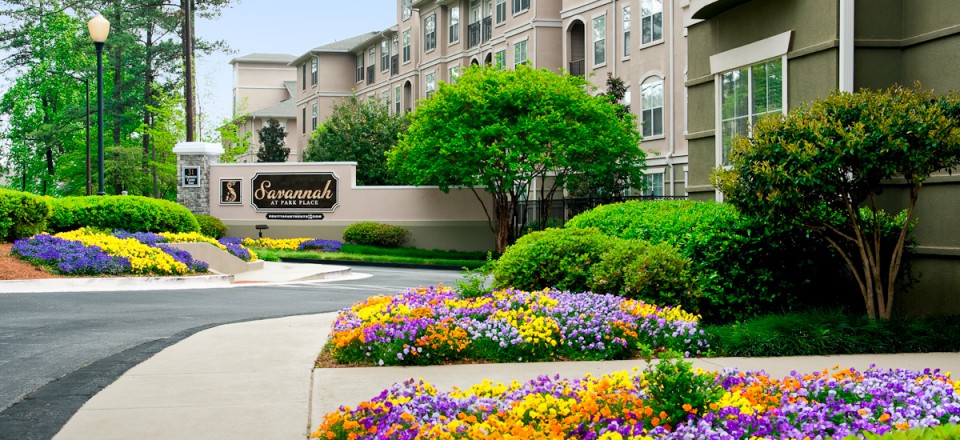
Converting a commercial property’s landscape to native plants is more than an eco-friendly gesture—it’s a smart financial move. Here’s a comprehensive breakdown of how native plant conversion for Atlanta landscapes helps save money while adding long-term value.
Significant Reduction in Water Usage
Before: Traditional turfgrass or exotic plants require regular irrigation, especially in hotter climates.
After: Native plants are adapted to local rainfall patterns and often thrive without supplemental watering once established.
- Commercial properties can reduce irrigation costs by 50–70%.
- In drought-prone regions, this also reduces fines or fees from municipalities.
Result: Thousands saved annually on water bills and infrastructure maintenance.
Lower Maintenance & Labor Costs
Before: Non-native landscapes need weekly mowing, fertilizing, pruning, and pest control.
After: Native plants maintain their shape and health with minimal upkeep.
- Less mowing = fewer landscaping hours.
- No need for chemical fertilizers or pest treatments.
- Long-term reduction in maintenance crew needs or contractor visits.
Result: Potential for 30–60% reduction in landscape service contracts.
Reduced Inputs (Fertilizers, Pesticides, Fuel)
Before: Keeping exotic species alive means constant input—synthetic fertilizers, pesticides, herbicides, and gas-powered equipment.
After: Native plants create a self-sustaining mini-ecosystem that supports local pollinators and resists pests naturally.
- Cut back on chemical costs.
- Less reliance on fuel-burning mowers and blowers.
Result: Fewer material purchases and a smaller carbon footprint.
Stormwater Management & Fee Savings
Before: Turf-heavy or poorly planned landscapes increase runoff, causing erosion or requiring costly stormwater infrastructure.
After: Native plant roots improve soil structure and water absorption, reducing runoff.
- Some municipalities offer stormwater fee reductions or credits for sustainable landscaping.
- Less need for retention ponds or artificial drainage systems.
Result: Environmental compliance and capital cost savings.
Increased Property Value & Public Perception
Before: Outdated landscaping with high maintenance costs can deter tenants or customers.
After: A native landscape signals a modern, sustainable, and socially responsible brand.
- Attracts eco-conscious clients and tenants.
- Qualifies for LEED credits or green certifications, which boost marketability.
Result: Long-term value appreciation, better tenant retention, and potential tax incentives.
Below is our list of top native plant conversion for Atlanta Landscapes:
Native Plants for Atlanta, Georgia
🌳 Native Trees
- Eastern Redbud (Cercis canadensis)
Small tree with pink spring blossoms; thrives in part shade. - Southern Magnolia (Magnolia grandiflora)
Iconic evergreen with large white flowers and glossy leaves. - American Holly (Ilex opaca)
Evergreen with red berries—great for wildlife. - Sweetgum (Liquidambar styraciflua)
Fast-growing with striking fall foliage. - Loblolly Pine (Pinus taeda)
Tall, fast-growing evergreen good for screening or erosion control.
🌿 Native Shrubs
- Virginia Sweetspire (Itea virginica)
Fragrant white flowers, vibrant red fall foliage. - Oakleaf Hydrangea (Hydrangea quercifolia)
Showy blooms and textured leaves—iconic Southeast native. - Wax Myrtle (Morella cerifera)
Fragrant, semi-evergreen shrub ideal for hedging. - Bottlebrush Buckeye (Aesculus parviflora)
Stunning summer flowers; thrives in shade.
🌸 Native Perennials & Wildflowers
- Black-Eyed Susan (Rudbeckia fulgida)
Bright yellow flowers, attracts butterflies. - Purple Coneflower (Echinacea purpurea)
Pollinator favorite, tolerant of heat and poor soil. - Butterfly Weed (Asclepias tuberosa)
Orange blooms, essential for monarchs. - Bee Balm (Monarda didyma)
Red/pink flowers, attracts bees and hummingbirds. - Blue Wild Indigo (Baptisia australis)
Spiky blue blooms and strong architectural form.
🌾 Native Grasses & Groundcovers
- Little Bluestem (Schizachyrium scoparium)
Ornamental grass with blue-green blades and orange fall color. - River Oats (Chasmanthium latifolium)
Attractive seed heads; great in partial shade. - Creeping Phlox (Phlox subulata)
Colorful spring carpet for sunny spots. - Green-and-Gold (Chrysogonum virginianum)
Low-growing groundcover with yellow flowers.
🐝 Why These Matter
These natives are:
- Drought-resistant after establishment
- Naturally pest-resistant
- Crucial for supporting native bees, butterflies, and birds
Native plants are transforming Atlanta landscapes into beautiful, low-maintenance spaces that thrive in the local climate while reducing water and upkeep costs. Contact us for more information.
